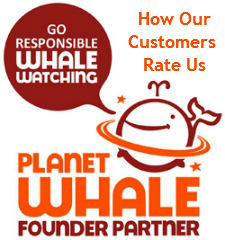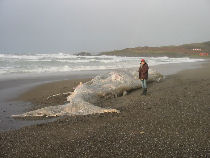Whale Conservation |
|
The proliferation in the use of synthetic fishing gear has been the single most important factor in the incidental deaths of cetaceans during the last 30 years. Annual deaths caused by incidental entanglement run into the hundreds of thousands around the world. Add to this the deliberate killing of dolphins and other small cetaceans where they are perceived to compete with humans for commercial fish species or for baiting crab pots then the pressure is likely to be unsustainable and active whale conservation measures are required immediately. It is not always clear what impact chemical and noise pollution has on cetacean populations but it is likely to impact reproduction and immune system integrity as has been demonstrated with land mammals that are close to the top of the food chain. We have yet to determine the damage of low frequency sonar on cetaceans but there is a growing body of evidence that numerous recent strandings of deep diving species like sperm whales and the beaked whales can be attributed to low frequency military sonar. Fish stocks the world over are under enormous pressure from commercial fishing operations. A number of fish stocks have collapsed most notable of these is the cod fishery off the eastern coast of Canada. Noise pollution and depletion of prey species at the very least may inhibit important activities such as nursing young or mating and may prove too much for an already compromised population. Increases in the amount of commercial and recreational watercraft have, and will continue to have, dramatic impact on some cetacean populations. Apart from the disturbance factor associated with increased shipping and waterborne leisure activities there is the very real danger of collision. Ship strike has undoubtedly been instrumental in preventing the recovery of the North Atlantic Right Whale; already reduced to a remnant through the excesses of the commercial whaling industry during the 19th and 20th centuries. On a much broader front global warming and human induced climate change are likely to have dramatic impacts on cetacean populations on a global scale. As polar ice caps melt reduced sea ice will influence the ability of krill to reproduce. The bottom of ice floes and sea ice is the main habitat for algae on which the krill feed. Reduced sea ice means reduced algae. Reduced algal populations will lead to reduced levels of krill. As krill are the basis of many Antarctic ecosystems the fate of the populations of marine mammals, birds and fish that prey on krill may, at best, be uncertain. Disturbance through unregulated and insensitive whale watching operations is something, which must be strenuously avoided. Emergent nations wanting to ensure valuable revenues to coastal communities through whale and dolphin watching must be given the necessary guidance and assistance to develop sustainable activities. During the 1980's when the moratorium on commercial whaling was introduced many could not envisage a return to the barbarity of the whaling era. Now, spearheaded by pro whaling nations like Iceland, Norway and Japan the world moves closer to a resumption of commercial whaling. These three nations have systematically flouted the moratorium and continued killing whales exploiting a loophole that permitted the taking of whales for scientific research. During the last 12 months Norway and Japan have significantly increased their Minke Whale kill to around a 1000 animals each and Japan has announced their intention to expand their kill to cover Fin Whales and Humpback Whales. The populations of both these species have shown significant recovery but are still considered at risk. If commercial whaling resumes it is likely to sound the death knell of many cetacean species and will say more about human nature and the depravity of human society in the 21st century than the exploits and excesses of man throughout the past 100 years ever could. The bestiality of past generations of man is well documented. Somehow, in the 21st century we expect something more cerebral from the Japanese and our neighbours in Iceland and Norway. At a time of unprecedented environmental degradation, habitat loss and dramatic reductions in biodiversity, the slaughtering of large whales by blowing out their vitals with an explosive harpoon must stop. The bestiality continues. The fight to stop them will continue and effective and lasting whale conservation measures must be put in place.
Read more about:
Return to TopOur Dolphin & Whale Watching Tours
|
Click on images for larger view:
|
Whale WatchingWhale Watching in IrelandWhale Watching TripsWhale Watching HolidaysDolphin WatchingDolphin EncountersDolphin HolidaysOther Marine Wildlife Tours |
More About WhalesWhale ConservationWhale PicturesMore About DolphinsDolphin PicturesPorpoisesSealsAbout
|
Inspirations
Nothing great in the world has been accomplished without passion.Georg Wilhelm













